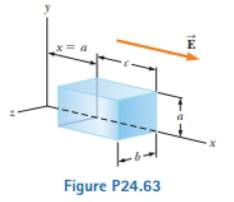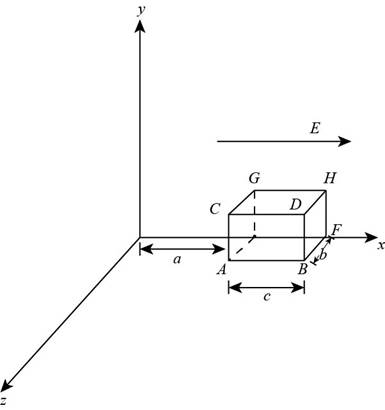
Concept explainers
A dosed surface with dimensions a = b= 0.400 111 and c = 0.600 in is located as shown in Figure 1*24.63. The left edge of the closed surface is located at position x = a. The electric field throughout the region is non- uniform and is given by

(a)
The net electric flux leaving the closed surface.
Answer to Problem 24.63CP
The net electric flux leaving the closed surface is
Explanation of Solution
Given info: The dimensions of the closed surface are
The position of the closed surface is,

Figure (1)
From the figure (1) the electric field is perpendicular to the normal of area ABEF, area CDHG, area ABCD and the area EFGH. Therefore,
The formula to calculate electric flux is,
Here,
The electric field makes an angle
Substitute
Thus, the flux out of the surface ABEF, CDHG, ABCD and EFGH is zero for the surfaces.
From figure (1), the area of the surface ACGE is,
From figure (1), the area of the surface BFDH is,
The electric flux in the
From figure (1), substitute
From Figure (1), substitute
The net flux leaving closed surface,
Here,
Substitute
Simplify the above equation.
Substitute
Conclusion:
Therefore, the net electric flux leaving the closed surface is
(b)
The net charge enclosed by the surface.
Answer to Problem 24.63CP
The net charge enclosed by the surface is
Explanation of Solution
Given info: The dimensions of the closed surface are
The flux enclosed by a closed surface is given by,
Here,
The permittivity of free space is
Substitute
Rearrange the above equation for
Conclusion:
Therefore, the net charge enclosed by the surface is
Want to see more full solutions like this?
Chapter 24 Solutions
Physics for Scientists and Engineers, Technology Update (No access codes included)
- please help me solve this questions. show all calculations and a good graph too :)arrow_forwardWhat is the force (in N) on the 2.0 μC charge placed at the center of the square shown below? (Express your answer in vector form.) 5.0 με 4.0 με 2.0 με + 1.0 m 1.0 m -40 με 2.0 μCarrow_forwardWhat is the force (in N) on the 5.4 µC charge shown below? (Express your answer in vector form.) −3.1 µC5.4 µC9.2 µC6.4 µCarrow_forward
- An ideal gas in a sealed container starts out at a pressure of 8900 N/m2 and a volume of 5.7 m3. If the gas expands to a volume of 6.3 m3 while the pressure is held constant (still at 8900 N/m2), how much work is done by the gas? Give your answer as the number of Joules.arrow_forwardThe outside temperature is 25 °C. A heat engine operates in the environment (Tc = 25 °C) at 50% efficiency. How hot does it need to get the high temperature up to in Celsius?arrow_forwardGas is compressed in a cylinder creating 31 Joules of work on the gas during the isothermal process. How much heat flows from the gas into the cylinder in Joules?arrow_forward
- The heat engine gives 1100 Joules of energy of high temperature from the burning gasoline by exhausting 750 Joules to low-temperature . What is the efficiency of this heat engine in a percentage?arrow_forwardL₁ D₁ L₂ D2 Aluminum has a resistivity of p = 2.65 × 10 8 2. m. An aluminum wire is L = 2.00 m long and has a circular cross section that is not constant. The diameter of the wire is D₁ = 0.17 mm for a length of L₁ = 0.500 m and a diameter of D2 = 0.24 mm for the rest of the length. a) What is the resistance of this wire? R = Hint A potential difference of AV = 1.40 V is applied across the wire. b) What is the magnitude of the current density in the thin part of the wire? Hint J1 = c) What is the magnitude of the current density in the thick part of the wire? J₂ = d) What is the magnitude of the electric field in the thin part of the wire? E1 = Hint e) What is the magnitude of the electric field in the thick part of the wire? E2 =arrow_forwardplease helparrow_forward
 Physics for Scientists and Engineers: Foundations...PhysicsISBN:9781133939146Author:Katz, Debora M.Publisher:Cengage Learning
Physics for Scientists and Engineers: Foundations...PhysicsISBN:9781133939146Author:Katz, Debora M.Publisher:Cengage Learning Physics for Scientists and Engineers, Technology ...PhysicsISBN:9781305116399Author:Raymond A. Serway, John W. JewettPublisher:Cengage Learning
Physics for Scientists and Engineers, Technology ...PhysicsISBN:9781305116399Author:Raymond A. Serway, John W. JewettPublisher:Cengage Learning Principles of Physics: A Calculus-Based TextPhysicsISBN:9781133104261Author:Raymond A. Serway, John W. JewettPublisher:Cengage Learning
Principles of Physics: A Calculus-Based TextPhysicsISBN:9781133104261Author:Raymond A. Serway, John W. JewettPublisher:Cengage Learning
 Physics for Scientists and EngineersPhysicsISBN:9781337553278Author:Raymond A. Serway, John W. JewettPublisher:Cengage Learning
Physics for Scientists and EngineersPhysicsISBN:9781337553278Author:Raymond A. Serway, John W. JewettPublisher:Cengage Learning Physics for Scientists and Engineers with Modern ...PhysicsISBN:9781337553292Author:Raymond A. Serway, John W. JewettPublisher:Cengage Learning
Physics for Scientists and Engineers with Modern ...PhysicsISBN:9781337553292Author:Raymond A. Serway, John W. JewettPublisher:Cengage Learning





